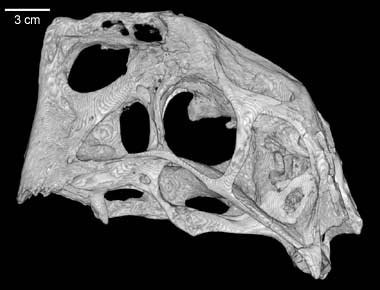|
|
From Clark et al. (2002):
The skull of the holotype of Citipati osmolskae is one of the best preserved oviraptorid skulls known. The skull preserves stapes and epipterygoids, and the mandible preserves a slender coronoid bone, none of which has been reported before in oviraptorids. The braincase is similar to that of other basal coelurosaurs but possesses extensive recesses presumably occupied by pneumatic diverticulae; the circumnarial region is highly pneumatized, and a large recess continues posteriorly from the narial region to invade the frontals and parietals dorsal to the braincase. Circum-otic pneumatic recesses include two dorsal recesses above the otic recess, a posterior recess on the anterior surface of the paroccipital process, and extensive cavities in the basisphenoid beneath the braincase. The more dorsal of the two dorsal tympanic recesses is very deep, and CT scans suggest that it connected medially across the midline dorsal to the otic region and anteriorly with the frontoparietal space. The otic recess is unusually shallow. Comparison of the new skull with the poorly preserved skull of the holotype of Oviraptor philoceratops demonstrates that the braincase and palate of the latter are similar to those of other oviraptorids. Its rostrum and dentary are more elongate than in other oviraptorids, however, a more plesiomorphic condition suggesting it may be the most basal oviraptorid. A well-preserved skeleton previously referred to O. philoceratops, IGM 100/42, does not belong to this genus or species, and its narial region is very similar to that of Citipati osmolskae.
 |
CT scan transverse sections through the holotype skull of Citipati osmolskae IGM 100/978 at three levels |

About the Species
This specimen, which in its entirety consists of a nearly complete skeleton, was collected from the Upper Cretaceous Djadokhta Formation of Ukhaa Tolgod, Mongolia. It was made available to The University of Texas High-Resolution X-ray CT Facility for scanning by Dr. James Clark of George Washington University and Dr. Mark Norell of the American Museum of Natural History. Funding for scanning was provided by a National Science Foundation Digital Libraries Initiative grant to Dr. Timothy Rowe of The University of Texas.

 |
Labeled right lateral photograph of the holotype cranium of Citipati osmolskae IGM 100/978.
|

About this Specimen
This specimen was scanned by Richard Ketcham and Cambria Denison in November 1997. The specimen was scanned along the sagittal axis for a total of 182 slices. Each slice is 0.5 mm thick with an interslice spacing of 0.5 mm. The field of reconstruction is 200 mm.

About the
Scan
Literature
Barsbold, R., T. Maryanska, and H. Osmolska. 1990. Oviraptorosauria; pp. 249-258 in D.B. Weishampel, P.Dodson, and H. Osmolska (eds.), The Dinosauria. University of California Press, Berkeley.
Clark, J.M., M.A. Norell, and R. Barsbold. 2001. Two new oviraptorids (Theropoda: Oviraptorosauria), Upper Cretaceous Djadokhta Formation, Ukhaa Tolgod, Mongolia. Journal of Vertebrate Paleontology 21:209-213.
Clark, J.M., M.A. Norell, and T. Rowe. 2002. Cranial anatomy of Citipati osmolskae (Theropoda, Oviraptorosauria), and a reinterpretation of the holotype of Oviraptor philoceratops. American Museum Novitates 3364:1-24.
Dong, Z.-M. and P.J. Currie. 1996. On the discovery of an oviraptorid skeleton on a nest of eggs at Bayan Mandahu, Inner Mongolia, People's Republic of China. Canadian Journal of Earth Sciences 33:631-636.
Elzanowski, A. 1999. A comparison of the jaw skeleton in theropods and birds, with a description of the palate in the Oviraptoridae. Smithsonian Contributions to Paleobiology 89:311-323.
Maryanska, T. and H. Osmolska. 1997. The quadrate of oviraptorid dinosaurs. Acta Palaeontologia Polonica 42:377-387.
Osborn, H.F. 1924. Three new Theropoda, Protoceratops zone, central Mongolia. American Museum Novitates 144:1-12.
Osmolska, H. 1976. New light on skull anatomy and systematic position of Oviraptor. Nature 262:683-684.
Padian, K., J.R. Hutchinson, and T.R. Holtz, Jr. 1999. Phylogenetic definitions and nomenclature of the major taxonomic categories of the carnivorous Dinosauria (Theropoda). Journal of Vertebrate Paleontology 19:69-80.
Sues, H.-D. 1997. On Chirostenotes, a Late Cretaceous oviraptorosaur (Dinosauria: Theropoda) from western North America. Journal of Vertebrate Paleontology 17:698-716.

Literature
& Links
None available.

Additional
Imagery
|
|



 ,
, 





